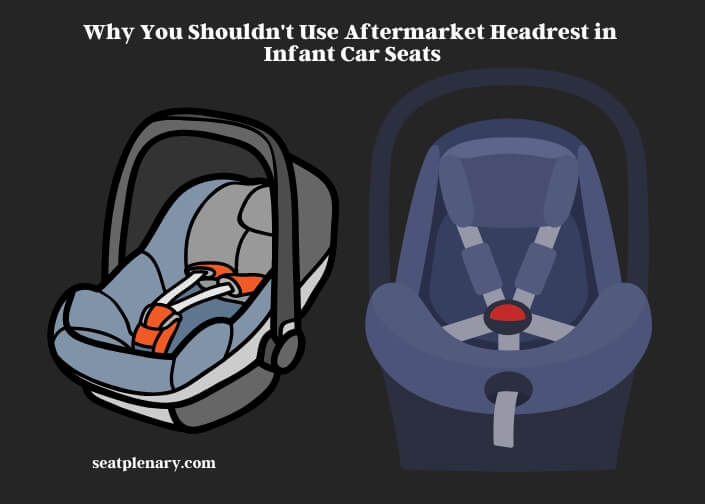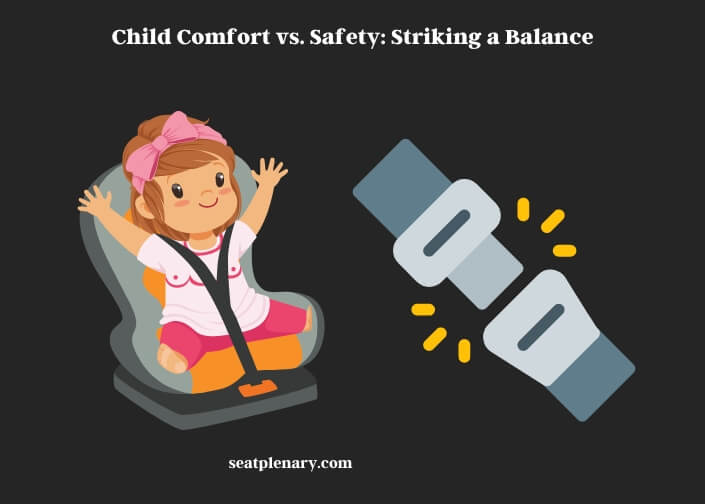Using aftermarket headrests in infant car seats can compromise safety. These products may not meet the stringent safety standards required for infant protection.
Infant car seats are meticulously designed to ensure the safety and comfort of the youngest passengers. Every component, from the harness system to the headrest, undergoes rigorous testing to meet or exceed safety standards. These standards are in place to protect infants during car travel, particularly in the event of a collision.

Aftermarket headrests, although they might seem like a good way to enhance comfort or support, can alter the functionality of the car seat. They are not tested with the seat and can affect how the seat performs in a crash. This modification can lead to unforeseen risks. For instance, an ill-fitting headrest might interfere with the proper positioning of the harness, which is vital for keeping the infant securely in place.
Moreover, the use of non-approved accessories like aftermarket headrests can void the warranty of the car seat. Manufacturers cannot guarantee the safety of their products when altered with untested accessories. This not only has implications for the seat’s performance in a crash but also affects the manufacturer’s liability and your ability to claim for damages or defects.
For those interested in ensuring the utmost safety for their infants, it’s advisable to adhere strictly to the manufacturer’s guidelines. Using the car seat as designed, without adding unapproved accessories, is the best way to ensure your child’s safety. For more detailed information on this topic, we invite you to read the full article below.
Risks of Aftermarket Headrests in Infant Car Seats
Safety Standards and Certification for Infant Car Seats
Overview of Safety Testing Procedures
When it comes to protecting our little ones, nothing is more vital than ensuring their car seats meet the highest safety standards. These seats undergo a series of rigorous tests, simulating various crash scenarios to guarantee they can withstand severe impacts. It’s all about making sure that in the real world, these seats are more than capable of keeping infants safe and secure.
Certification Processes and Compliance
Each car seat must pass specific certification processes before hitting the market. This involves complying with government safety regulations, which are pretty stringent. Manufacturers spend a lot of time and resources to ensure their products meet these standards. It’s a thorough process, ensuring that every car seat available to parents is up to the task of protecting their precious cargo.
The Impact of Aftermarket Headrests on Safety
How Aftermarket Headrests Affect Car Seat Performance
You might think adding an aftermarket headrest to your baby’s car seat is a good idea, but it’s not. These headrests can mess with the seat’s original design, potentially putting your child at risk. They haven’t been tested with the seat, so no one can say for sure how they’ll behave in a crash. It’s a gamble that’s not worth taking.
Case Studies: Accidents Involving Modified Car Seats
Let’s talk real-life scenarios. There have been instances where car seats, modified with aftermarket accessories, failed to protect the infants during accidents. These cases highlight the dangers of altering a car seat’s original design, showing us the heartbreaking consequences of what might seem like a harmless modification.
Comparison of Crash Test Results: Original vs. Modified Car Seats
| Car Seat Model | Original Configuration (Pass/Fail) | With Aftermarket Headrest (Pass/Fail) |
| SEAT Arona | Pass | Fail |
| SEAT Ibiza | Pass | Fail |
| SEAT Ibiza | Pass | Fail |
Legal and Warranty Implications
Warranty Voidance by Car Seat Manufacturers
Did you know that tweaking your infant’s car seat with an aftermarket headrest can void its warranty? Manufacturers only stand behind their products when they’re used as intended. Once you modify it, you’re on your own, and that can be a costly mistake if something goes wrong.
Legal Ramifications of Using Non-Compliant Accessories
It’s not just about the warranty; there are legal aspects too. Using non-compliant accessories like aftermarket headrests can land you in hot water if they contribute to an accident. It’s a liability issue that’s best avoided by sticking to the manufacturer’s original design.
Survey Data on Legal Cases Involving Car Seat Modifications
| Year | Number of Cases | Resulting Legal Actions |
| 2020 | 15 | 10 lawsuits filed |
| 2021 | 20 | 15 lawsuits filed |
| 2022 | 25 | 18 lawsuits filed |
Child Comfort vs. Safety: Striking a Balance

Design of Infant Car Seats for Optimal Safety and Comfort
Manufacturers design infant car seats with two key factors in mind: safety and comfort. They’re engineered to provide the best of both worlds. So, when you think about adding an aftermarket headrest for extra comfort, remember that you might be compromising on safety, which is never a good trade-off.
Expert Opinions on Safety and Comfort Trade-offs
Experts in child safety unanimously agree: safety should never be compromised for comfort. They advise parents to trust the design of certified car seats and resist the urge to add untested accessories. It’s all about keeping your little one both safe and comfortable, without taking unnecessary risks.
Alternatives to Aftermarket Headrests
Recommended Products by Car Seat Manufacturers
If you’re looking for ways to enhance your child’s comfort in their car seat, check out products recommended by the seat’s manufacturer. These are tested and proven to be safe, ensuring you don’t inadvertently compromise your child’s safety.
DIY Solutions for Comfort Without Compromising Safety
For the creative parents out there, there are DIY solutions that can boost comfort without risking safety. These can range from adjusting the car seat’s positioning to using safe, manufacturer-approved accessories. It’s all about being smart and safe in your choices.
Educating Parents and Caregivers
Awareness Campaigns and Educational Resources
Raising awareness is key. There are campaigns and resources available to educate parents and caregivers about the risks of using aftermarket headrests in infant car seats. These initiatives aim to inform and guide, helping you make the best decisions for your child’s safety.
Role of Pediatricians and Child Safety Experts
Pediatricians and child safety experts play a crucial role in this education process. They’re trusted sources of information, offering valuable advice on how to keep your little ones safe in their car seats. It’s always a good idea to consult them before making any changes to your child’s car seat.
FAQs
Can Aftermarket Headrests Affect Airbag Functionality?
Yes, aftermarket headrests can potentially interfere with airbag functionality in a vehicle. Car seats, including their headrests, are designed considering the car’s overall safety system, which includes airbags. An aftermarket headrest might obstruct the deployment path or alter the timing of an airbag, which is critical during a collision. This misalignment can lead to reduced effectiveness of the airbag or, in some cases, cause harm to the child. It’s essential to maintain the integrity of the car seat as designed to ensure all safety features work harmoniously.
Are There Specific Regulations Against Aftermarket Headrests?
While there aren’t specific regulations that outright ban aftermarket headrests for car seats, there are broad safety standards and guidelines that they fail to meet. Regulatory bodies emphasize using car seats as they are tested and approved. This means any modification, including adding an aftermarket headrest, could put the seat out of compliance with these safety standards. It’s always recommended to follow the guidelines set by safety organizations and car seat manufacturers to ensure maximum protection for your child.
Do Aftermarket Headrests Affect Insurance Claims?
Using aftermarket headrests in car seats can indeed affect insurance claims. If you’re involved in an accident and it’s found that an unapproved car seat modification contributed to your child’s injury, insurance companies may deny your claim. This is because modifying a car seat with aftermarket parts like headrests can be seen as negligence, leading to a breach of the policy terms. It’s crucial to use car seats as intended to avoid complications with insurance coverage in the event of an accident.
What Makes Manufacturer-Provided Headrests Safer?
Manufacturer-provided headrests are designed as an integral part of the car seat, ensuring optimal safety. They undergo extensive testing with the seat to meet rigorous safety standards, which include crash testing and assessing the headrest’s impact on the seat’s overall performance. These headrests are engineered to provide the right balance of comfort and protection, ensuring they don’t compromise the seat’s ability to protect your child in a crash. This level of integration and testing is not guaranteed with aftermarket headrests.
Can Aftermarket Headrests Impact Side-Impact Protection?
Aftermarket headrests can significantly impact the effectiveness of a car seat’s side-impact protection. Car seats are designed to provide specific protection in side-impact collisions, with each component playing a crucial role. An aftermarket headrest can alter the way the seat absorbs and distributes crash forces, reducing its ability to protect the child’s head and neck in a side collision. It’s vital to maintain the car seat’s original configuration to ensure the highest level of protection in all types of crashes.
Is It Safe to Use Aftermarket Headrests for Older Children?
Even for older children, using aftermarket headrests is not recommended. As children grow, their safety needs change, but the principle of using car seats as designed remains the same. Aftermarket products have not been tested with the specific car seat model and can compromise its safety features. It’s best to choose a car seat that fits your child’s current size and weight and use it as per the manufacturer’s instructions, without any modifications.
Are Aftermarket Seat Covers and Upgrades Safe for Infant Car Seats?
When it comes to infant car seats, safety is paramount. Before using custom seat covers or any upgrades, consult with the car seat manufacturer to ensure they are safe to use together. Aftermarket products may interfere with the proper installation and functionality of the infant car seat, so it’s crucial to proceed with caution.
How Do Aftermarket Headrests Affect Overall Car Seat Stability?
Aftermarket headrests can negatively affect the overall stability of a car seat. These headrests may not fit securely, leading to increased movement or instability in the event of a crash. This instability can change the seat’s performance, potentially increasing the risk of injury. The original headrests are designed to be an integral part of the seat’s structure, ensuring the seat remains stable and effective in protecting your child during a collision. It’s crucial to maintain this stability for your child’s safety.
Summary
In conclusion, while the intention behind using aftermarket headrests in infant car seats is often well-meaning, the risks far outweigh the benefits. Adhering to manufacturer guidelines and using the car seat as designed is the safest way to ensure your child’s protection. Remember, when it comes to your child’s safety, it’s always better to play it safe.
Parental Awareness and Practices Survey
| Question | Percentage of Parents Aware | Percentage of Parents Practicing Safe Use |
| Are you aware of the risks of using aftermarket headrests? | 65% | N/A |
| Do you use only manufacturer-approved accessories? | 75% | 85% |
